Files in this item
Effect of halide-mixing on tolerance factor and charge-carrier dynamics in (CH3NH3PbBr3-xClx) perovskites powders
Item metadata
| dc.contributor.author | Siddique, Zumaira | |
| dc.contributor.author | Payne, Julia L. | |
| dc.contributor.author | Irvine, John T. S. | |
| dc.contributor.author | Jagadamma, Lethy K. | |
| dc.contributor.author | Akhter, Zareen | |
| dc.contributor.author | Samuel, Ifor D. W. | |
| dc.contributor.author | Iqbal, Azhar | |
| dc.date.accessioned | 2021-09-22T23:36:43Z | |
| dc.date.available | 2021-09-22T23:36:43Z | |
| dc.date.issued | 2020-09-23 | |
| dc.identifier | 270683655 | |
| dc.identifier | 02cdec21-e478-4682-9d9b-1f687e348222 | |
| dc.identifier | 000572323900011 | |
| dc.identifier | 85091411273 | |
| dc.identifier.citation | Siddique , Z , Payne , J L , Irvine , J T S , Jagadamma , L K , Akhter , Z , Samuel , I D W & Iqbal , A 2020 , ' Effect of halide-mixing on tolerance factor and charge-carrier dynamics in (CH 3 NH 3 PbBr 3-x Cl x ) perovskites powders ' , Journal of Materials Science: Materials in Electronics . https://doi.org/10.1007/s10854-020-04475-4 | en |
| dc.identifier.issn | 0957-4522 | |
| dc.identifier.other | ORCID: /0000-0002-8394-3359/work/82179216 | |
| dc.identifier.other | ORCID: /0000-0003-3324-6018/work/82179665 | |
| dc.identifier.other | ORCID: /0000-0002-4339-2484/work/82179674 | |
| dc.identifier.uri | https://hdl.handle.net/10023/24005 | |
| dc.description | The authors are highly thankful for the financial support of Higher Education Commission (HEC) Pakistan through the equipment/research grants (6976/Federal/NRPU/R&D/HEC/2017), (20-3071/NRPU/R&D/HEC/13). Author ZS acknowledges HEC for indigenous PhD Fellowship Phase-II, Batch-II, 2013, PIN 213-66018-2PS2-127 and International Research Support Initiative Programme (IRSIP). Author LKJ acknowledges support from a Marie Skłodowska-Curie Individual Fellowship (European Commission) (MCIF: No. 745776). | en |
| dc.description.abstract | This work demonstrates a route to making mixed halide perovskite powders at room temperature by the anti-solvent-assisted crystallization method. Although, mixed halide CH3NH3PbBr3−xClx perovskites have been prepared by different methods, however, to the best of our knowledge the anti-solvent-assisted crystallization method is employed here for the first time to prepare mixed halide CH3NH3PbBr3−xClx perovskite powders. Solution-processed methyl ammonium lead tribromide CH3NH3PbBr3 (x = 0) and different amounts of chloride (Cl) containing mixed halide perovskites (CH3NH3PbBr3−xClx) were prepared for compositions of x = 0.5, 1, 1.25, 1.75. It reveals that bulk CH3NH3PbBr3−xClx samples are highly crystalline and exists in pure single cubic phase with an increased tolerance factor as compared to pure CH3NH3PbBr3. The CH3NH3PbBr3 perovskite has space-group Pm-3 m and a cell parameter of 5.930 Å (volume = 206 Å). The synthesis route adopted here gives access to hybrid perovskites powders with high Cl content and hence enables the band gap to be precisely tuned over a range from 2.26 to 2.49 eV. The powder samples display the subtle shifts in the emission spectra and the photoluminescence kinetics exhibits a decrease in average lifetime by increasing the Cl contents due to the presence of trap states in the structures that encourage non-radiative recombination of charge carrier. Conventionally, the CH3NH3PbBr3-based inverted solar cell architecture is prepared via mixing of the CH3NH3Br and PbBr2 precursors. In contrast, herein, the precursor solutions are directly prepared from the CH3NH3PbBr3 powder and the active layer of the inverted perovskite solar cells are then spin coated using this solution. The high Voc value of the fabricated solar cells potentially makes it a promising candidate for tandem photovoltaic, photocatalytic water splitting, and semi-transparent photovoltaic applications. | |
| dc.format.extent | 14 | |
| dc.format.extent | 1392583 | |
| dc.format.extent | 388051 | |
| dc.language.iso | eng | |
| dc.relation.ispartof | Journal of Materials Science: Materials in Electronics | en |
| dc.subject | Solar-cells | en |
| dc.subject | 2-Step deposition | en |
| dc.subject | Hybrid perovskite | en |
| dc.subject | Quantum dots | en |
| dc.subject | Efficient | en |
| dc.subject | Route | en |
| dc.subject | Crystallization | en |
| dc.subject | Recombination | en |
| dc.subject | Nanocrystals | en |
| dc.subject | Diffusion | en |
| dc.subject | QD Chemistry | en |
| dc.subject | TK Electrical engineering. Electronics Nuclear engineering | en |
| dc.subject | NDAS | en |
| dc.subject | SDG 7 - Affordable and Clean Energy | en |
| dc.subject.lcc | QD | en |
| dc.subject.lcc | TK | en |
| dc.title | Effect of halide-mixing on tolerance factor and charge-carrier dynamics in (CH3NH3PbBr3-xClx) perovskites powders | en |
| dc.type | Journal article | en |
| dc.contributor.sponsor | European Commission | en |
| dc.contributor.institution | University of St Andrews. School of Chemistry | en |
| dc.contributor.institution | University of St Andrews. Centre for Designer Quantum Materials | en |
| dc.contributor.institution | University of St Andrews. EaSTCHEM | en |
| dc.contributor.institution | University of St Andrews. School of Physics and Astronomy | en |
| dc.contributor.institution | University of St Andrews. Centre for Biophotonics | en |
| dc.contributor.institution | University of St Andrews. Condensed Matter Physics | en |
| dc.identifier.doi | 10.1007/s10854-020-04475-4 | |
| dc.description.status | Peer reviewed | en |
| dc.date.embargoedUntil | 2021-09-23 | |
| dc.identifier.grantnumber | 745776 | en |
This item appears in the following Collection(s)
Items in the St Andrews Research Repository are protected by copyright, with all rights reserved, unless otherwise indicated.


